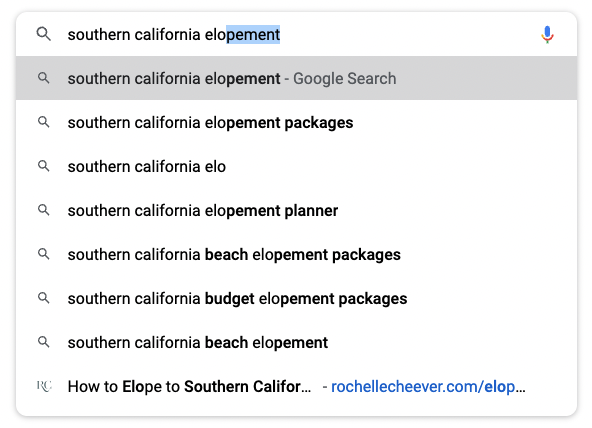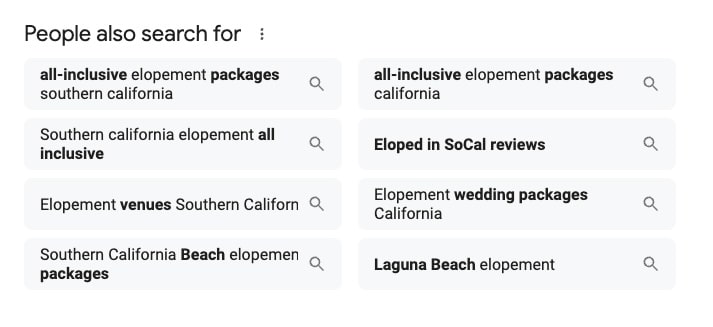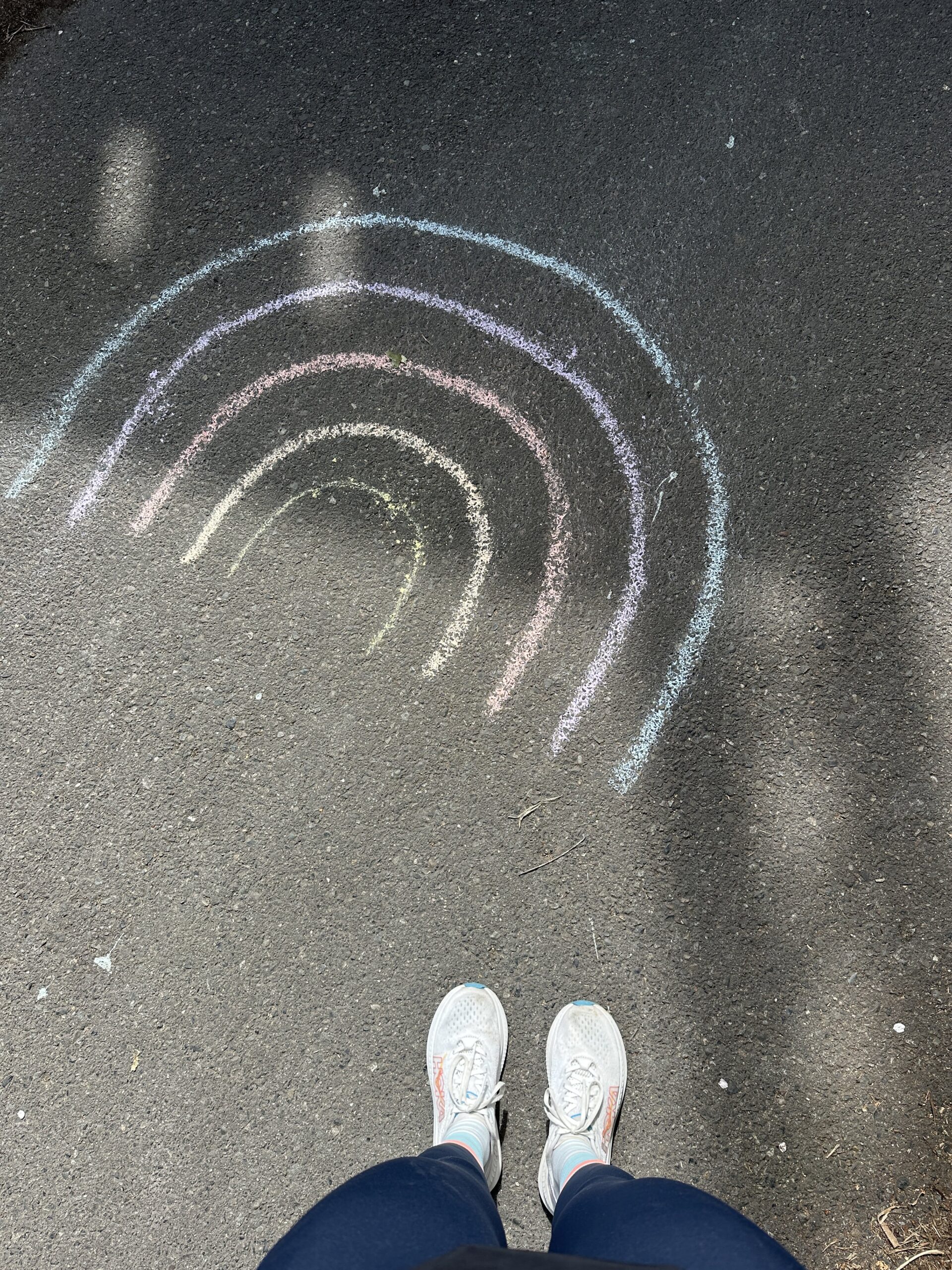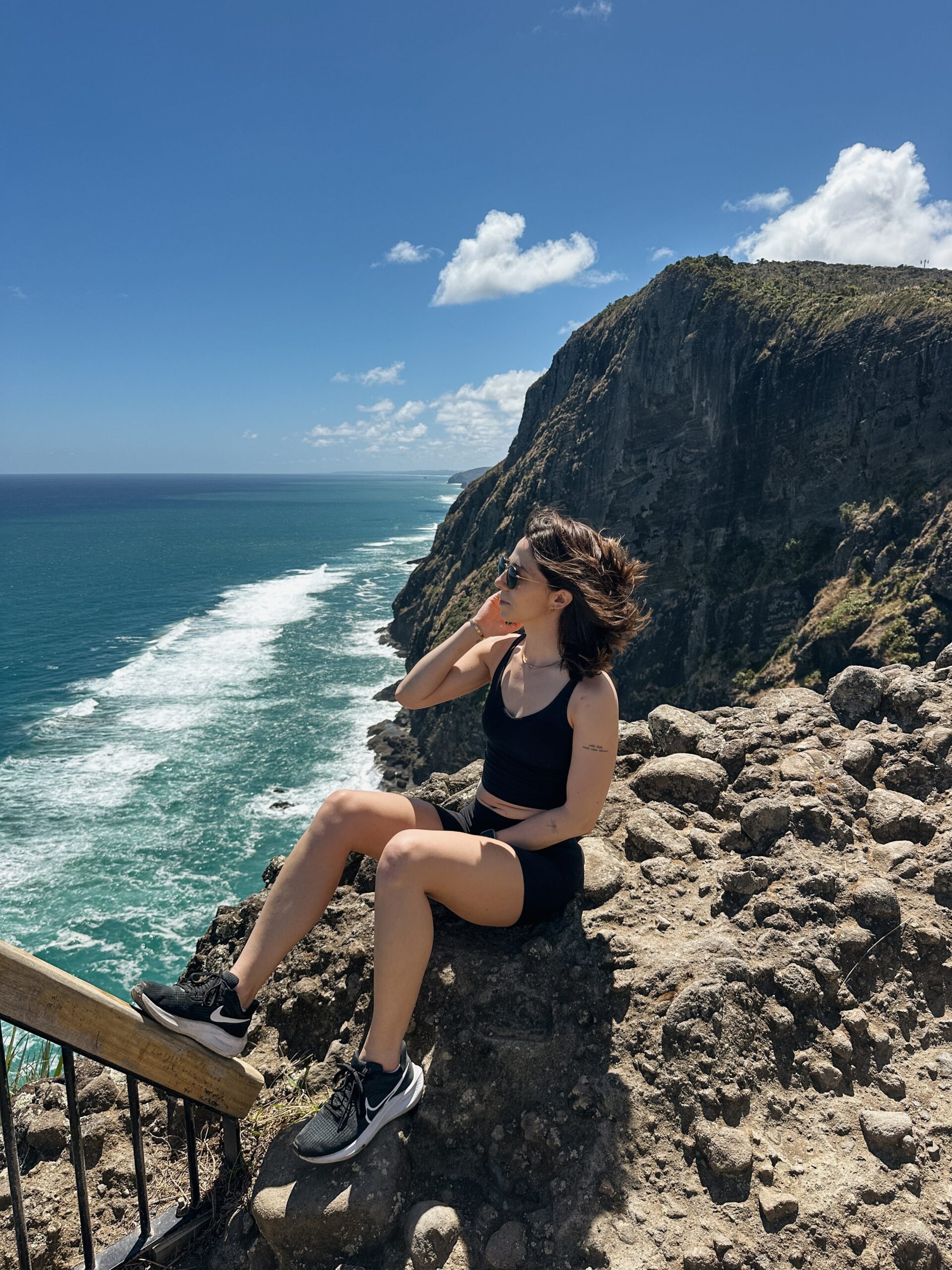SEO for Wedding Photographers: Everything You Need to Know
The Ultimate Guide on How to Optimize Your Wedding Blog
SEO. Most wedding photographers either love it or hate it, and if you’re in the latter club, I get it! SEO for wedding photographers is a huge and confusing topic, so if you’re feeling overwhelmed, know you are not alone.
However, SEO is crucial to getting your work seen and found by potential clients – so it’s not something you want to ignore. If you’re a wedding photographer who is looking to master SEO and attract more clients through your website (and stop relying on social media), you need to understand the core concepts of SEO – especially when it comes to blogging.
That’s where this blog post comes in. In this guide, I’ll walk you through ten SEO tips for wedding photographers – tips that will help you optimize your wedding blog posts and increase your online visibility.
What is SEO?
First things first – what the heck is SEO? (And yes, that was a real question I found on Google!) 🙃.
SEO stands for “search engine optimization”. It is a series of processes and algorithms used by search engines to evaluate the overall strength of your website. The more you follow the rules and guidelines of SEO, the higher your site will rank on search engines like Google (making it that much easier for potential clients to find you and engage with your content!).
Think about it this way – when you look up information online, chances are, you click on the first 1-3 articles that pop up. You may scroll and browse some of the links below, but do you ever scroll to page 2 or 3? My guess is not very often.
That is why SEO is so valuable. By improving and adhering to SEO best practices, your site has a greater chance of ranking higher on search engines and getting seen by the right people.
💡 Pro Tip – Search engines need time to crawl your site and index it correctly, so it knows who to show it to. You won’t jump to page one overnight (oftentimes, it can take 6-12 months for you to start seeing a measurable difference). However, consistency and high-value content that follows SEO best practices are key, and in time, the results will pay off!
10 SEO Tips for Wedding Photographers
1. Know Your Audience
Before creating any content, it’s essential to understand who you’re speaking to. What topics are your clients searching for and why? What problem are they trying to solve (it could be as simple as needing a photographer for their wedding day or not knowing where they should elope)? Are they looking for inspiration or information?
By identifying and understanding your client’s needs first, you’ll know what type of content to create and what your audience is most interested in engaging with. From there, you can tailor your blog content to address their specific questions and concerns.
2. Choose Your Keyword(s)
Keywords are one of the most important pillars of SEO for wedding photographers. But what is a keyword? How do you find keywords, and how do you know which ones to use?
What are SEO keywords?
A keyword is any word or phrase someone enters into a search engine. Some examples of keywords are:
- Washington elopement photographer
- How to get married in washington state
- Micro wedding venues washington state
Keywords can be one or two words, or they can be full sentences.
Your keywords should be used throughout your blog post, and they are how search engines determine what your blog is about. Keywords are a key piece to creating SEO-friendly blog posts, so finding and choosing the right ones is crucial.
How to find SEO keywords
Once you’ve identified the topic of your blog post, it’s time to find your SEO keywords. Brainstorm a list of words or phrases that you might look up about your topic if you were in your client’s position.
Keywords can include locations, venues, colors, details, etc., and they can also come in the form of sentences or questions.
💡 Pro Tip – A great place to start when looking for SEO keywords for your blog post is on Google itself.
Once you have a couple of ideas, head over to your browser and start entering them in the search bar. As you begin typing, your search engine will auto-populate other search queries in the drop-down list below. These phrases are the most popular terms that other people are currently searching for and are great keywords to add to your list of ideas.

Another place you can look for SEO keyword ideas on Google is in the “People also search for” section at the bottom of the page. These are other common searches related to your topic that can help provide additional keyword ideas if needed.

While Google is a great (and completely free) tool, I recommend using a keyword research tool to check your keywords’ strength and popularity. There are a lot of tools on the market, but my top recommendations are:
Each of these sites has different features, but all will tell you how many monthly searches a keyword gets as well as how hard it will be to rank for that word or phrase.
Want to learn more about each of these tools and see some of the other blogging tools I use and love? Click here to get my 25 top blogging tools that will save you time and make blogging a whole lot easier.
What makes a good keyword?
By now, you hopefully know the importance of keywords and understand that you don’t want to choose just any keyword! When it comes to choosing a good keyword, there are three main things you want to consider:
- Relevance – How relevant is it to your blog post’s topic?
- Volume – How many monthly searches does it receive?
- Competition (SEO difficulty) – How easy is it to rank for?
Using one of the keyword research tools I mentioned earlier, look for keywords that match the topic you plan to write about. Aim for keywords with a high number of monthly searches, but a low competition rate.
How many keywords should you use in a blog post?
The number of keywords you need in a blog post primarily depends on the length of your content and the type of post you are writing. For instance, longer blog posts can include more keywords, while shorter posts don’t need as many.
In general, focus on one main keyword that closely matches your topic and 1-3 secondary keywords that complement your main keyword and support your topic.
For example, if I were writing a blog post about “How to Elope in Washington State”, based on the below examples, I would choose “elope in washington” as my primary keyword because it has the highest volume (ie – number of monthly searches) and a low SEO difficulty score. I could also use “washington elopement” as a supporting keyword as it relates to my topic as it ranks similarly in volume and SEO difficulty. I wouldn’t use “washington wedding” as it doesn’t as closely match my topic, and it’s harder to rank for.

BONUS: Research Keywords for Voice Search
Voice searches are becoming more and more popular these days. This means it’s important to also optimize for words and phrases people are likely to use when speaking.
Most voice searches are:
- Long tail keywords (3 words or more)
- Conversational in form
- Questions
When researching your keywords, pay attention to the “people also ask” section on the results page as well as the questions area within the detailed keyword overview of your keyword research platform (you can navigate to this section in Ubersuggest by clicking on the individual keywords).
💡 Pro Tip – Don’t forget to consider location-based keywords too. Venue and location keywords can help you book weddings in specific areas and help search engines associate your content with regional searches.
*Bonus Local SEO Tip – Want to go a step further? Make sure your Google Business Profile is fully optimized and includes your service location. Include a short, keyword-friendly description and keep it updated with client reviews. This improves your visibility in local search results and helps build trust with potential clients.
Strong keywords are one of the biggest pieces of the puzzle when it comes to SEO for wedding photographers. If you want your blog posts to rank and attract your dream clients, focus on finding the best keywords and optimizing for different search types to have the best chance of getting your blog post seen by the right people.
3. Optimize Your Photos
Did you know that text isn’t the only place you should optimize your wedding blog? Search engines don’t just scan your written content, they also scan your photos. This is why it’s important to make sure your images are properly resized and optimized for SEO.
How to Optimize Your Wedding Blog Images
Compress the Image File Size
Large files slow down your website’s loading time, which negatively impacts your SEO score. This is why it’s important to compress your images before uploading them to your blogging platform.
- Download web-size photos from your online photo gallery.
- Upload the photos to a photo optimizer like CompresJPEG. (Note – this tool only allows 21 uploads at a time, so you may have to work in batches).
- Once the photos have been run through the platform, download them to your desktop.
Have a gif or two that you would like to add to your blog post to better tell the story? You can optimize gifs as well through Ezgif. Here’s how:
- Download web-size gifs from your online photo gallery.
- Upload the file to Ezgif and compress. (I recommend using as little compression as possible to maintain the quality of the image).
- Resize the image (1200-1500 px width or height, depending on it’s orientation).
- Download to your desktop.
💡 Pro Tip: Aim for a gif file size no bigger than 8-10mb for the most optimal load time.
Rename Your Photos To Include Keywords
The next step is to rename your image files. Your file name gives Google clues to the image’s content, and it’s an important piece of the SEO puzzle.
When renaming your blog photos, here are a few tips:
- Use short, descriptive file names to describe the photo’s content (ie – micro wedding reception dinner). Aim to keep the description around 3-5 words.
- Avoid generic photo names (ie – IMG0021.jpg or ThePritchetsWedding002.jpg).
- Separate words with hyphens to allow search engines to more easily read their format.
Example: micro-wedding-reception-dinner.jpg
You’ll want to follow this renaming pattern for as many images as possible. However, I get that it can take a long time to do this for 40 different photos on every single blog post. Rather than stress about perfectly naming every single image, focus on renaming 5-10 key photos using the format above. The remaining photos can simply be named with your primary keyword or something else related to the blog’s topic.
Add Alt-Text Keyword Descriptions
According to Google, the most important attribute of an image’s metadata is its Alt-Text.
Alt-Text is text added to your image settings within your blog platform. The text describes an image in greater detail, and it’s beneficial for three reasons:
- Helps search engines understand the subject matter of your image and categorize it properly.
- Improves accessibility for readers who have visual impairments or who use screen readers.
- Shares details about the image in the event it cannot be displayed due to an error or a weak internet connection.
Because Alt-Text is the most important image SEO factor, you will want to add it to every image on your site (this one’s important, so no shortcuts here!).
Here are a few tips for properly adding Alt-Text to your images:
- Focus on describing the main image details.
- Include your keywords (primary or secondary). I recommend rotating through them as they apply to the image, however, you don’t need a keyword on every photo.
- Don’t keyword stuff!
- Keep the descriptions short and under 125 characters (ie – a short sentence). You don’t need to use the full character amount, though. 4-5 words are ok.
Example: Guests sitting under a white tent with string lights during a Washington micro wedding reception dinner.
Utilize Keyworded Captions
Utilizing captions is a great way to further optimize your wedding blog post images.
People are scanners, and they may not always read your blog posts word for word. This is where utilizing the proper headings and captions can help your most important information stand out.
For educational posts, aim to use photos only where they reinforce the content. If appropriate, add a caption to emphasize certain points.
✨ Fun fact: Captions get read more than body copy…four times more! (Source: Neil Patel).
If you want to learn more about how to use captions and images properly throughout your blog post, the link above has some really interesting data.
4. Give Your Blog Post Structure with Headings
Before I ever write the copy for a blog post, I always start by creating an outline first.
An outline with the proper headings helps provide structure to your post and makes it easier for the reader to navigate.
Your primary headings (H2 and H3) are also what search engines crawl when scanning your post.
When formatted correctly, headings make it easier for search engines (and people) to scan and understand the structure of your content and find the information they need.
SEO Headings Best Practice
So, what are the best practices for using headings in your blog posts?
First and foremost, your headings should include some of your keywords…no surprise there! 🙂 And it’s worth mentioning again – no keyword stuffing!
💡 Pro Tip: You do not have to use your keyword(s) in every heading. 30-75% of your H2 and H3s is a good rule of thumb; however, prioritizing natural language is more important than keyword placement.
How you structure your headings is also very important. There are several levels of headings, H1, H2, H3, H4, and so on. If it helps, you can think of your blog headings like you would a book.
- H1 (Blog title) = Book title
- H2 = Book chapters
- H3 and below = Sections or subsections within the chapter
Each webpage should only have one H1, which serves as your title. Keep it specific, include your primary keyword, and explain what readers can expect to read about within the article.
Your H2s help break up the main topics within your blog post and explain what the following paragraphs are about, while H3s dive into more specific detail.
5. Add Your Copy
Now it’s time to write your blog copy. Check out this resource for tips on how to write a real wedding blog post, or this one if you are looking for tips on how to write an evergreen blog post.
No matter what type of blog post you are writing, by now, you should know that keyword stuffing is a no-go. So then, what is the right number of keywords to use in a blog post? While Google doesn’t specify the exact number or formula, a good rule of thumb is 1-2% of your overall blog length. For example, if you have a 1,000-word blog post, you should aim to use your keywords 10-20 times.
A few additional tips for optimizing your wedding blog copy:
- Include your primary keyword within the first 100 words of your post.
- Make your blog post is scannable by breaking up long paragraphs and using lists or bolded text.
- Write for people. Following the proper rules of SEO for wedding photographers is important, but remember, you are writing to a person, not a machine. Write like you are speaking to your reader, because you are!
6. Add Internal and External Links
When it comes to adding links to your blog, there are two types of links to think about – internal and external. Both are extremely important to use and can help your page rank higher on Google.
What Are Internal Links?
Internal links are links that send the reader to another page of your website. They can link to your main pages (such as your pricing or contact page) or other blog posts with related information.
For instance, if you are writing a blog post about an elopement in the North Cascades, consider linking to other North Cascades elopements and resources. This helps encourage readers to click around your site and provides a better experience for them as it share additional inspiration and education they may find valuable.
Of course, there are also SEO benefits for adding internal links to your blog posts. Internal links also connect your content and give search engines an idea of the structure of your website. (Source: Yoast SEO). Essentially, internal linking creates a map of your site and helps search engines understand which pages are the most important. Pages linked to more frequently will be ranked higher than pages with fewer internal links.
What Are External Links?
External links are hyperlinks that point to other websites or domains. For example, the link to Yoast SEO in the paragraph above is considered an external link.
It may seem counterintuitive to share links that send people away from your site. However, linking to quality, trustworthy material is valuable for both you and your audience.
By pointing them to additional information that will help them, you are providing value, which is what blogging is truly about.
Additionally, pointing to authoritative resources relevant to your topic will increase your content’s credibility and help search engines understand how to categorize your content in comparison.
BONUS: What are Backlinks?
There is a third type of link (which we won’t get into too much detail in this post), called backlinks. Backlinks are very valuable for SEO! Getting another website to link to your site is one of the most valuable forms of linking because that link essentially acts as a “vote” that your content is worth reading. Of course, the quality of the link matters, but the more you can get, the more it will increase your overall SEO score.
7. Add Relevant Categories & Tags
When it comes to helping your readers navigate your blog page, categories and tags are two of the most powerful features of your blog. But, so often, I see photographers (and wedding pros in general) make the mistake of using way too many and using them incorrectly.
Every time you create a new category or tag, you generate a new URL. Too many similar or duplicate categories/tags can confuse search engines and hurt your SEO. This is why it’s important to be intentional about which categories and tags you create.
Categories vs Tags: What’s the Difference?
While both categories and tags help organize your content, they serve slightly different purposes.
- Categories are the broad pillars of your blog. Think of them like the main services or content types you offer (aka – book genres).
- Tags go one layer deeper. They describe more specific details about each post, like location, setting, or even client type.
What to Use for Blog Categories
If you’re a wedding or elopement photographer who also occasionally shoots other sessions, here are some examples of relevant blog categories:
- Weddings
- Elopements
- Vow Renewals
- Couples Sessions
- Planning Tips
💡 Pro Tip: Categories should appear near the top of your blog or be easily searchable so visitors can quickly browse the topics most relevant to them.
When adding categories to your blog post, choose 1–3 that most closely match your post’s topic.
What to Use for Blog Tags
Tags let you get more specific with the details of each blog post. When coming up with a list of tags, think about the locations, types of landscape, or even client identities that are most relevant to your business. Don’t stress about creating a tag for every single location or landscape. If you find that you are shooting in a new location more frequently, you can always add a tag down the road.
Here are some examples of smart tag options:
- Washington
- Oregon
- California
- International
- Italy
- Mountains
- Beaches
- Forest
- Mt. Rainier National Park
- Yosemite National Park
- LGBTQ+
A few questions you can ask yourself when creating blog post tags:
- Where was this session or event?
- What kind of setting or terrain did it take place in?
- Are there identity-based or storytelling elements worth highlighting?
Choose 3–10 tags per post that truly reflect the content. It’s worth repeating – tags are not the place to get spammy. Keep them relevant and helpful.
Using categories and tags intentionally means you’re not only creating a better user experience for your audience, but you’re also helping search engines properly index and rank your content.
8. Create a Unique Meta Description
Remember the book analogy we used in section 4? Well, we’re going to add meta descriptions to the list.
Every webpage has a meta description – a summary of what your blog post (aka book) is about. These descriptions appear in search results under the title of your page. They give your readers a quick preview of what the blog post is about and are crucial in a reader deciding whether or not to click on your post.
Tips for writing a strong meta description:
- Keep it short. 150-160 characters is all that the reader will see.
- Use descriptive language. Describe what the blog post is about.
- Include your primary keyword (you knew this was coming).
- Include a CTA (call-to-action). Give the reader a reason to click on your post by using words like “Learn more”, “Click here”, or “You have to see”.

A clear meta description is a powerful wedding photographer SEO strategy that, when used correctly, can help drive even more clicks to your blog post.
9. Customize Your URL Slugs
Your slug is the part of your URL that comes after the last backslash. URL slugs are auto-populated whenever you create a new blog post or webpage, but they should always be updated before publishing your post.
Having a clearly defined slug is another way to make your website easier to crawl, not to mention it’s easier to read and looks more professional.
Tips for customizing your URL slug:
- Keep it short. 3-5 words are best.
- Use your primary keyword.
- Write in all lowercase and separate words by dashes.
Example: /seo-for-wedding-photographers/
Having a clean URL allows for a more user-friendly experience and can improve your search rankings.
💡 Pro Tip: Once a slug is chosen, try to avoid changing it. Slugs should stay consistent for the long term. If you need to change it, set up a redirect to ensure it continues working properly.
10. Create Valuable Content
All of the above wedding photographer SEO steps won’t mean anything if your website isn’t providing value to your readers. SEO is important, but writing for your readers first is what truly matters!
Work to create high-quality, informative, and engaging content that addresses your audience’s needs. And remember, creating value doesn’t always mean education. Other ways you can provide value are by sharing a story, showcasing your work, and offering tips that will make their life easier.
SEO is a long game. You won’t see results overnight. But, with time and by following SEO best practices, you’ll be well on your way to ranking and getting your blog posts seen by your dream clients.
If you’re ready to start implementing these wedding photographer SEO tips, download my free checklist for an easy-to-reference guide you can use while creating your posts.
And, if you prefer to focus on what you do best and have someone else handle the SEO for you, click here to learn more about our blogging services. Our packages are designed to help you scale your business and marketing (without the extra effort). Ready to hand it off now? Contact us here!

Hi, I’m Kiersten
A fellow traveler, experience enthusiast, and marketing expert. I love partnering with wedding and elopement professionals to help them reach their dream clients!
Check out some of our other Wedding Photographer SEO resources

Wondering how to get your wedding featured and get those “as seen in” badges for your website? Click to read my top wedding publication tips!
Marketing Tips
Featured
Stop guessing what to blog. Here are 22 strategic blog post ideas for wedding photographers that build trust, traffic, and visibility.

A wedding inspiration blog isn’t just pretty. It can also build trust, spark ideas, and help your dream clients say, “This is what we want.”

How a wedding photography FAQ blog builds trust, saves time, boosts SEO, and answers client questions (before they even ask).


